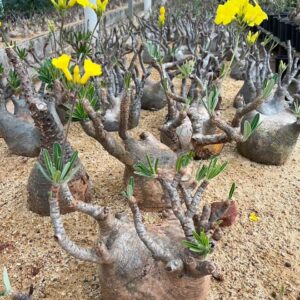Encephalartos Heenanii
Encephalartos heenanii, commonly known as Heenan’s Cycad or Woolly Cycad, is a critically endangered species of cycad native to the border regions of South Africa and Eswatini (formerly Swaziland). Here are some key characteristics and conservation status details:
-
: This cycad is medium-sized with an erect stem that can grow up to 3 meters tall and 25-35 cm in diameter. It often develops basal suckers. The leaves are light green, 100-125 cm long, with lanceolate leaflets arranged oppositely on the rachis. The stem crown is covered by a thick, golden brown woolly layer.
-
: It is dioecious, meaning there are separate male and female plants. Male cones are yellow, ovoid-shaped, and about 27-30 cm long. Female cones are similar in shape but slightly smaller, typically 23-30 cm long.
-
: Encephalartos heenanii is listed as Critically Endangered due to severe threats such as habitat destruction, illegal poaching for private collections, and the impact of pine plantations which disrupt natural fire cycles necessary for coning.
-
: The remaining wild population is estimated to be less than 400 mature individuals, with numbers continuing to decline.
-
: Found in Barberton, Mpumalanga, South Africa, and adjacent areas in Eswatini.
-
: Grows in open grasslands on steep slopes at about 1500 meters altitude, experiencing hot summers and cold winters with significant summer rainfall.
-
: This species is notoriously difficult to cultivate, as mature plants often do not survive transplantation due to drying out or fungal infections. It also rarely cones in cultivation, making seeds scarce.
-
: The species was named by Robert Allen Dyer in 1972 and honors Denis Heenan, who first brought the plant to scientific attention
What are the main threats to Encephalartos heenanii
The main threats to Encephalartos heenanii, or Heenan’s Cycad, are:
Illegal Poaching and Trade:
The persistent pressure from plant collectors is a significant threat. This cycad is highly valued for private collections and landscaping, leading to its removal from the wild. The illegal trade is driven by demand for large, mature specimens, which are difficult to replace due to the species’ slow growth rate.
Habitat Destruction and Alteration:
The planting of pine plantations has disrupted natural fire cycles necessary for coning, further threatening the species. Habitat loss and alteration due to human activities like agriculture and urbanization also contribute to its decline.
Slow Reproduction Rate:
Encephalartos heenanii is a slow-growing species that does not reproduce frequently in nature. This makes it particularly vulnerable to population decline when mature plants are removed.
Environmental Factors:
Changes in environmental conditions, such as those caused by invasive species or altered fire regimes, can also impact the species’ survival. However, the primary threats remain poaching and habitat disruption.
In 2022, Encephalartos heenanii was reassessed as extinct in the wild due to these persistent threats




Reviews
There are no reviews yet.